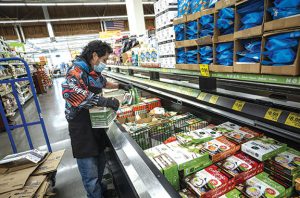Bloomberg
The Biden administration announced $2.1 billion in new funding to bolster food supply chains, including the efforts to support smaller processors and help farmers shift to the organic production.
The initiatives will begin to have an impact on lowering food inflation “as we get in the tail end of 2022
and into 2023,†Agriculture Secretary Tom Vilsack told reporters after the announcement.
Weaknesses in the US food supply chains have been underscored by a nationwide shortage of baby formula following the shutdown of a single Abbott Labs production facility, empty grocery shelves in the early days of the pandemic and soaring food prices in the past year. Grocery prices in April were up 10.8% from a year earlier, the highest annual increase since November 1980, when Jimmy Carter was in the White House.
“We should begin to see some moderation†in grocery price increases, Vilsack said. That will be driven by “the combination of the supply chain being smoothed out from the pandemic and the ability of funding from this program to begin to expand capacity.â€
Vilsack plans to focus on moving US food supplies away from the dominance of a few highly concentrated businesses while addressing climate change challenges in a new “framework†for strengthening supply chains.
He announced initiatives including $600 million in assistance for independently owned supply-chain infrastructure such as cold storage and refrigerated trucks. That aid will come on top of funding Biden announced earlier this year to help independent processors expand in the highly concentrated meatpacking industry.
The US Department of Agriculture also announced $400 million to create regional food business centers to support small- and mid-sized farms and food processors, $300 million to assist farms transitioning to organic production and a $155 million increase for a program to promote healthy options in “food deserts†in low-income areas underserved by grocery stores.
Funding for the initiatives will come from the Biden-backed $1.9 trillion Covid-19 relief plan Congress passed last year “and other relief legislation,†according to advance material the USDA provided to reporters.
US economy shows signs of downshifting
US economic growth looks to have downshifted in recent weeks in the face of headwinds that include rising interest rates and inflation, the Federal Reserve said.
Expansion and price gains may be moderating in parts of the country as households and businesses navigate higher rates, the Russian invasion of Ukraine and ongoing disruptions from Covid-19 infections, the central bank said in its Beige Book report.
“Four districts explicitly noted that the pace of growth had slowed since the prior period,†it said. Business contacts in several districts reported becoming more cautious as their outlooks grew more pessimistic.
Fed officials lifted interest rates by a half point in May and signalled they are likely to make similar increases in June and July as they work to tame the hottest inflation in decades. Policy makers are aiming to reduce demand for labour, in turn cooling wage growth and helping to lower inflation, without tipping the economy into recession.
A separate report by the Labour Department showed that US job openings fell in April from a record in the prior month but remained elevated, with roughly two job openings for every unemployed American. That suggests little relief for employers struggling to attract and retain workers. Another update on the labour market will come on Friday, when the government releases the jobs report for May.
 The Gulf Time Newspaper One of the finest business newspapers in the UAE brought to you by our professional writers and editors.
The Gulf Time Newspaper One of the finest business newspapers in the UAE brought to you by our professional writers and editors.
